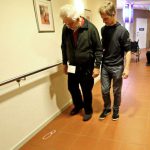[M22 project by João Paulo Lammoglia]
 The project revolves around the Freezing of Gait (FOG) phenomenon occurring among elderly patients with Parkinson’s disease (PD). FOG is the temporary, involuntary inability to move and it can be experienced on turning, in narrow spaces, whilst reaching a destination, and in stressful situations. FOG is one of the most disabling and common mobility disorder in PD, and is usually observed in the advanced stages of the disease (Nieuwboer, 2013). Gait impairment and FOG seriously affect the quality of life of patients as it can lead to an unpredictable loss of control over movement and can result into falls.
The project revolves around the Freezing of Gait (FOG) phenomenon occurring among elderly patients with Parkinson’s disease (PD). FOG is the temporary, involuntary inability to move and it can be experienced on turning, in narrow spaces, whilst reaching a destination, and in stressful situations. FOG is one of the most disabling and common mobility disorder in PD, and is usually observed in the advanced stages of the disease (Nieuwboer, 2013). Gait impairment and FOG seriously affect the quality of life of patients as it can lead to an unpredictable loss of control over movement and can result into falls.
The effectiveness of the Sensory cueing in improving gait in PD patients has been established by different researchers (Bagley, 1991) (Freedland, 2002). Sensory cueing can be defined as the use of external temporal or spatial stimuli to facilitate movement, gait initiation and continuation (Nieuwboer, 2007). It can be divided into three modalities: visual cueing; auditory cueing; and tactile cueing. Visual cues help to enlarge the stride length and generate sufficient amplitude movement (Azulay, 1999), while auditory cues help to stabilize the gait timing (Freedland, 2002).
The goal for this project is to combine the established scientific knowledge on FOG and Sensory cueing with an in-depth User Research into the design of an intelligent product/service for the assistance of a more independent lifestyle for PD patients with FOG symptoms.
In this document it is described my design vision and connected to it motivation for my Final Master Project. After, information about the context and project can be found. It is illustrated the project development, design approach, outcomes and future steps.
FULLTEXT: PDF